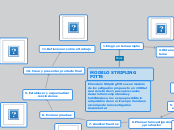La investigacion cientifica y el Metodo cientifico
In linguistics, syntax is the set of rules, principles, and processes that govern the structure of sentences in a given language, usually including word order.
Proceso de la Investigación Científica
A compound sentence is a sentence that has at least two independent clauses joined by a comma, semicolon or conjunction. An independent clause is a clause that has a subject and verb and forms a complete thought.
En la lógica del proceso investigativo encontramos las siguientes tres etapas estructurales básicas:
When independent clauses are joined with coordinators (also called coordinating conjunctions), commas and semicolons, they do more than just join the clauses. They add meaning and flow to your writing.
La investigación comprende los siguientes pasos:
El ensayo cuidadoso de las conclusiones para determinar si encajan con las hipótesis formuladas
La recopilación, organización y valoración de datos.
La formulación de hipótesis o soluciones sugeridas.
La definición y redefinición de problemas
3.- Etapa de elaboración del informe de la investigación o de comunicación de los resultados.
En esta etapa recibe el reconocimiento a su esfuerzo y, lo que es para él aún más importante, de la comunidad científica, que le es clave para continuar investigando
2.- Etapa de ejecución del proyecto o de desarrollo de la investigación
Cuando se sabe qué hacer y cómo hacerlo, entra en la etapa del raciocinio o del trabajo de campo y de laboratorio es la etapa de la consecución, interpretación y análisis de la información
1.- Etapa de concepción, planeamiento y formulación del proyecto de investigación científica
Quien se dedica a formular el proyecto elabora un documento en el cual se especifican los aspectos tecnicos y administrativos que se requieren para la investigacion.
Pasos de la investigacion
El ensayo cuidadoso de las conclusiones para determinar si encajan con las hipótesis formuladas.
La formulación de deducciones y alcance de consecuencias
La recopilación, organización y valoración de datos
La formulación de hipótesis o soluciones sugeridas
La definición y redefinición de problemas.
El método científico
A complex sentence is a sentence that contains an independent clause and one or more dependent clauses.
An independent clause can stand alone as a sentence, but a dependent clause even though it has a subject and a verb cannot stand alone.
Es aplicado por el metodologo ya que se ocupa del planteamiento de los problemas que las hipotesis intentan resolver y de su comprobacion.
Attributive clauses serve as an attribute to a noun (pronoun) in the main clause. This noun or pronoun is called the antecedent of the clause.
Nos lleva a eliminar el plano subjetivo en la interpretación de la realidad, permitiéndonos la objetividad en el proceso investigativo
An adverbial clause is a group of two or more words that function as an adverb in a sentence.
Es un conjunto de conocimientos racionales, ciertos y probables, obtenido metódicamente, sistematizados y verificables, que hacen referencia a objetos de una misma naturaleza
An appositive clause follows another noun or noun phrase in apposition to it; that is, it provides information that further identifies or defines it.
Tipos de Investigación Científica
Otros tipos de investigación
See the example below and try to create your own simple sentences.
Tim is driving the red car.
Correlacional
Estudio del caso
Investigación ex post facto sobre hechos cumplidos
Experimental - Describe lo que será
See the example below and try to create your own simple sentences.
Tim is the driver.
Presenta diversos tipos de diseños experimentales
cuasiexperimentales
experimentales
preexperimentales
Es la manipulación de una variable experimental no comprobada, en condiciones controladas, con el fin de describir de qué modo o por qué causa se produce una situación o acontecimiento particular.
2.- Descriptiva - Interpreta lo que es.
See the example below and try to create your own simple sentences.
Tim drives the car.
La tarea del investigador en este tipo de investigación tiene las siguientes etapas:
B) Muestra
6. Categorías de datos, a fin de facilitar relaciones.
7. Verificación de validez de instrumentos.
8. Descripción, análisis e interpretación de datos.
A) Población
1. Descripción del problema.
2. Definición y formulación de hipótesis.
3. Supuestos en que se basan las hipótesis.
4. Marco teórico.
5. Selección de técnicas de recolección de datos.
Trabaja sobre realidades de hecho, y su característica fundamental es la de presentamos una interpretación correcta
1.- Histórica - Describe lo que era.
See the example below and try to create your own simple sentences.
Tim drives.
La tarea del investigador en este tipo de investigación tiene las siguientes etapas
5. Interpretación e informe
4. Formulación de hipótesis
3. Crítica de las fuentes
2. Recolección del material informativo
1. Enunciación del problema
Se presenta como una búsqueda crítica de la verdad que sustenta los acontecimientos del pasado.
Investigacion cientifica
Recoge conocimientos o datos de fuentes primarias y los sistematiza para el logro de nuevos conocimientos.
The predicate of a sentence is the part that modifies the subject in some way. Because the subject is the person, place, or thing that a sentence is about, the predicate must contain a verb explaining what the subject does and can also include a modifier.
Ocupa el método científico para resolver tipos de problemas.
El investigador parte de resultados anteriores y para ello debe:
3.- Crear instrumentos si no estan creados
2.- Recoger, registar y analizar los datos obtenidos
1.- Planear una metodologia
Es el instrumento por el que la ciencia logra llegar al conocimiento científico
The subject of a sentence is the person, place, thing, or idea that is doing or being something. You can find the subject of a sentence if you can find the verb.
Ask the question, 'Who or what 'verbs' or 'verbed'?' and the answer to that question is the subject.
Como base fundamental de las ciencias, parte de la realidad, investiga esa realidad, la analiza, formula hipótesis y fundamenta nuevas teorías o con muy poco conocimiento de ella









